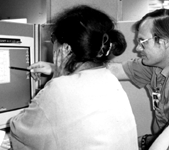| T H E N I H C A T A L Y S T | N O V E M B E R - D E C E M B E R 1 9 9 6 | |||
DCRT OFFERS MATH
SOFTWARE AND |
by Lipika Samal |
|||
|
DCRT's Scientific Computing Resource Center (SCRC), a walk-in computing facility for NIH re-searchers, recently began offering support for mathematical software packages that perform functional analyses and symbolic manipulation, solve linear and nonlinear equations, and have exceptional graphics. The mathematics programs - Mathematica, Math Cad Plus, and MatLab - are useful in modeling biological processes and designing experiments. Indeed, observes Philip McQueen, SCRC mathematics coordinator, "as computer science, information science, and mathematics become more closely linked with biological research, mathematical software will continue to become increasingly valuable." Some programs, like the popular Mathematica, are available on Helix and Advanced Laboratory work stations.
SCRC, now entering its fifth year of operation, also provides software in other areas of scientific computing, such as image processing, molecular modeling, and statistical data analysis. Staff members with extensive knowledge of many of the programs' applications are available to assist users by appointment. To the newcomer, SCRC, located on the first floor of Building 12A, may look like a room full of computers, but the facility offers much more than equipment. Expert consultants advise users on mathematics, statistics, image analysis, and scientific web publishing. Researchers work at Mac Quadra, PowerMac, Pentium, Silicon Graphics, and SUN work stations, running a variety of software packages, and can use the center's color printers, scanners, and other hardware, which many labs do not own. SCRC also supports programs such as NIH Image, a free public domain program used for gel densitometric analysis, and programs that facilitate tissue segmentation and cell counting. The center's computer scientists and engineers have also assisted researchers in the development of web sites. One beneficiary of their expertise is Lothar Hennighausen, a researcher in NIDDK's Laboratory of Biochemistry and Metabolism who studies the development, differentiation, and function of the mammary gland. Hennighausen recently joined forces with SCRC's Jai Evans to create a web site that disseminates information to researchers worldwide. The site, which can be found at http://scrc.dcrt.nih.gov/~mammary, is "a true web presence," according to Luther Barden, head of the SCRC. Barden describes the site, which now gets about 200 visits a week, as "a journal, an encyclopedia, and a textbook all under one roof, where you can find everything from techniques to literature to reviews to histology." For other researchers hoping to create a scientific web site, SCRC can offer guidance and software and can temporarily host the site on one of SCRC's servers. SCRC's own web page (http://scrc.dcrt.nih.gov/) gives up-to-date information about the center's services as well as links to outside sources, such as software tutorials, software manufacturer pages, and e-mail addresses for a wide network of support staff. "It's a great starting place for information about image processing, molecular modeling, and mathematical and statistical software at NIH," says Evans. To use the facility, researchers may schedule an appointment by calling 4-DCRT or by e-mailing <4dcrt@nih.gov>. |
||||
